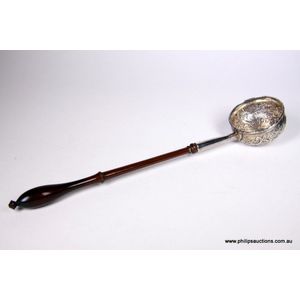Georgian Coin-Inset Silver Toddly Ladle with Baleen Handle
You must be a subscriber, and be logged in to view price and dealer details.
Subscribe Now to view actual auction price for this item
When you subscribe, you have the option of setting the currency in which to display prices to $Au, $US, $NZ or Stg.
- Georgian - As an English stylistic period, Georgian is usually taken to cover the period from George I (1714) to the Regency of Prince George (1811-20), although the period from 1800 to 1830 is sometimes designated as the Regency period. During the Georgian period the great English cabinetmakers and designers such as Chippendale, Hepplewhite, Adam Sheraton etc., were all active.
Therefore there isn't a single 'Georgian style' as such and to say something is 'Georgian', usually means it was made between 1714 and 1830. This assumes we discount George V and George VI, both being from the 20th century.
The styles popular at the time of each reign were:
George I (1714-1727) saw out the last years of the Baroque period.
George II (1727-1760) reigned during the Rococo period.
George III (1760-1820) saw the last gasp of the Rococo, all of the early Neo-Classic 'Adam style' and most of the later neo-Classic 'Regency style'.
George IV (Prince Regent 1820-1830)encompassed the last of the 'Regency' style.
William IV's reign (1830-1837) was something of a no man's land (stylistically) and he wasn't a 'George' anyway. He covered the last glimmerings of 'Regency' and the start of the 'Victorian' style. - Baleen - Baleen is the filter feeder system in a baleen whale, and these whales have several hundred plates of baleen with a hairy fringe on their upper jaw.
Baleen refers to the solid plate, and it is historically important as it was sought by whalers as a by-product of the whaling industry, who called it whalebone, though it is not made of bone at all, and used it for scrimshaw.
The earliest artefacts were made of baleen produced from Arctic whaling in the 17th century.
In the 19th century baleen was an important raw material, comparable to present-day plastics. Its thermoplastic nature and strength meant it could be used to make a wide variety of functional and decorative objects.
Sailors used baleen to make sewing boxes and other small containers and another common use was brush bristles; it was even used as runners on toboggans.
Baleen basketry was developed into a craft, with examples of simple baskets to complex woven ones, which could take months to complete.
Other shore-based uses included in corsets, buggy whips, umbrella ribs, canes, skirt hoops and especially as a cheaper substitute for ivory in carving. - George Ii - George II (1683 - 1760) was King of Great Britain and Ireland from 1727 until his death in 1760.
This item has been included into following indexes:
Visually similar items

A George III sterling silver and whale bone oval toddy ladle by Elizabeth Morley, London 1797

A George II silver coin toddy ladle with a timber handle, early to mid 18th century. the compressed cauldron shaped bowl richly decorated in the rococo manner with vines and scrolls, having a George II coin to the bowl, a silver mount with engraved initial

A ladle by Georg Jensen. The acorn pattern ladle, hallmarked Georg Jensen sterling Denmark, 14 cm length.

Antique sterling silver toddy with whale bone handle and set with 1663 coin, 33 cm long approx
